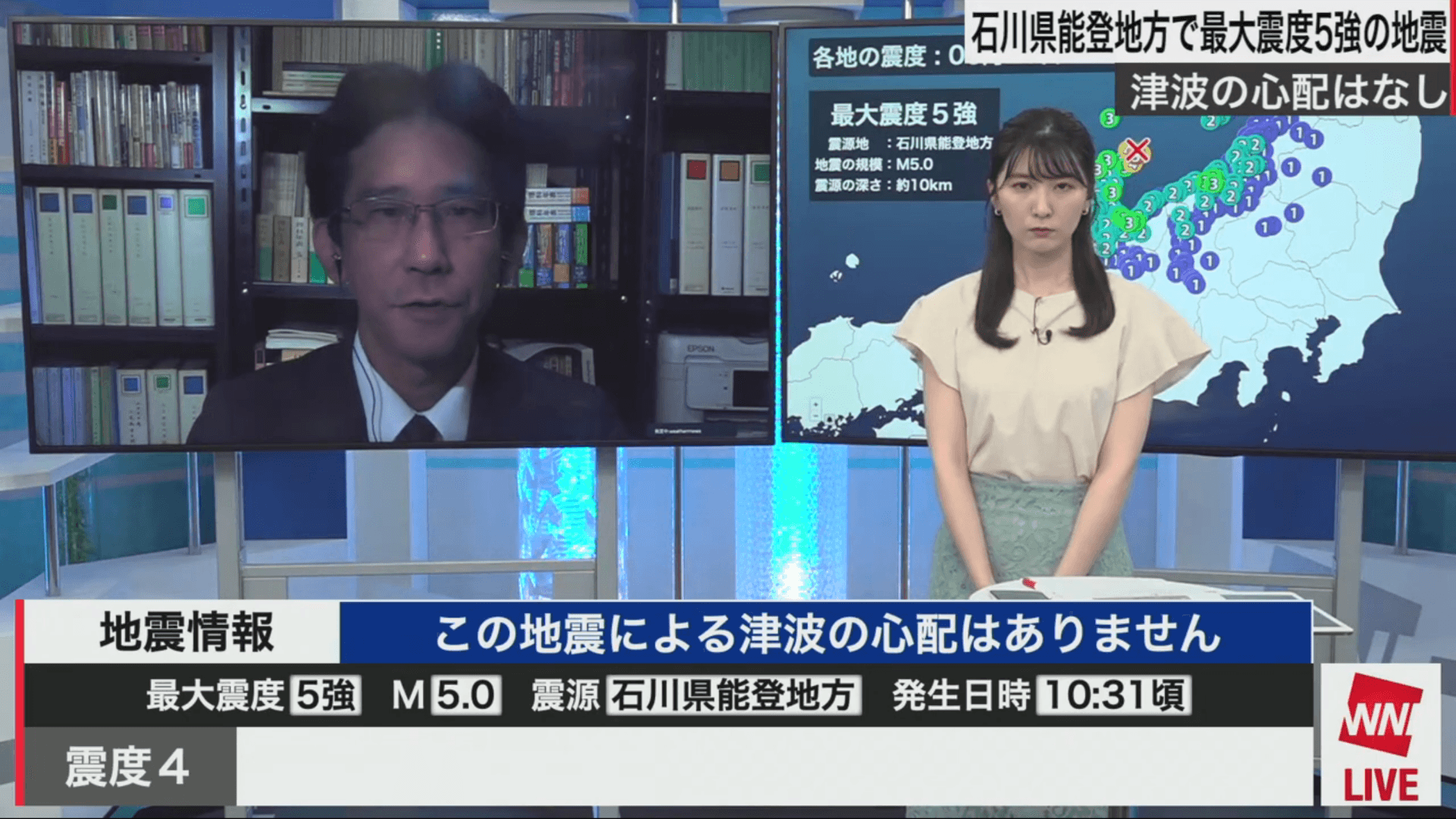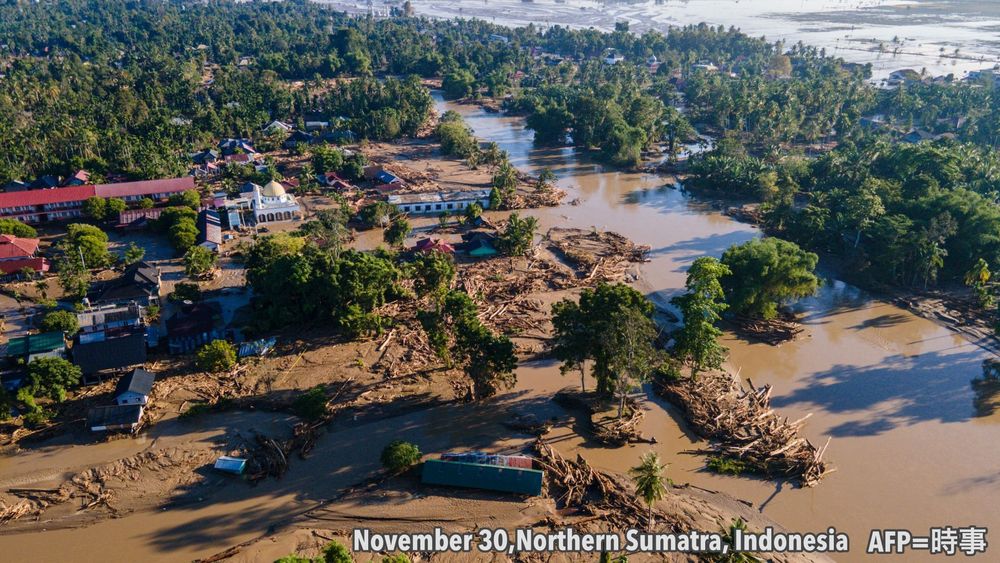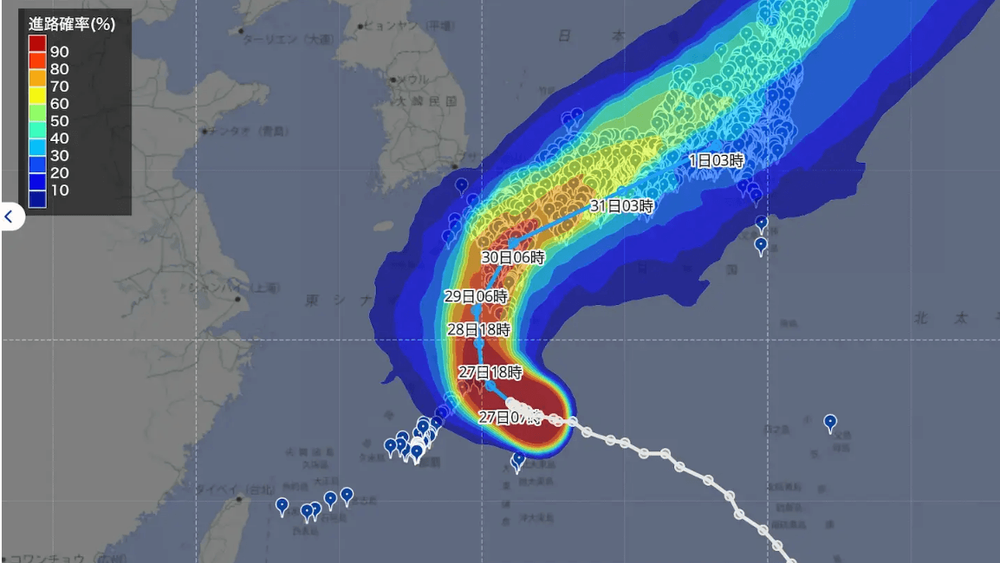August 7, 2025
Behind the Scenes: Weathernews LiVE's Rapid Earthquake Response
The moment we feel an earthquake, countless questions and anxieties flood our minds. In these critical situations, we need fast and accurate information to protect lives and make the right decisions.
Our company delivers real-time earthquake updates through the Weathernews app and operates Weathernews LiVE, a 24/7 weather information program with 1.45 million YouTube subscribers (as of July 2025). When earthquakes strike, we transition to earthquake coverage faster than any other program.
We sat down with Kazuhisa Hayashi from the LiVE production and production team to discuss earthquake broadcasting on Weathernews LiVE, his approach to communicating with viewers during these tense moments, and the weekly earthquake drills that keep the team prepared.
Viewership Surges 40x After Earthquakes - Why Viewers Turn to Us in Critical Moments
Earthquakes strike without warning, anytime and anywhere. When strong shaking hits, whether you're going about your day or sleeping, your first instinct is probably to reach for your phone and find out what's happening. With Weathernews LiVE broadcasting 24/7 on YouTube and TikTok, you can get answers instantly, right from your phone.
Weathernews LiVE immediately transitions to earthquake-focused coverage when seismic events occur. During these moments, our viewership can jump up to 40 times normal levels. This dramatic increase shows that viewers trust Weathernews LiVE as their go-to source for earthquake information.
We believe viewers choose us for three key reasons: our unmatched speed in reporting earthquake information, our expertise through detailed analysis by commentators with specialized knowledge, and our interactive approach that incorporates real-time information from viewers themselves.
Lightning-Fast Response: 24-Hour Live Broadcasting That Switches to Earthquake Coverage Instantly
When the Japan Meteorological Agency issues an Earthquake Early Warning, emergency alarms sound in the sub-control room (broadcast sub-studio) next to the studio, and program staff immediately switch the broadcast screen. It takes just a few seconds from when an earthquake occurs until the Earthquake Early Warning appears on the Weathernews LiVE screen.
Even after the shaking stops, we have systems ready to deliver information about epicenters and seismic intensity from the Japan Meteorological Agency at top speed with almost no delay.

Even when major earthquakes strike late at night, Weathernews LiVE has commentators provide detailed explanations through live online broadcasts from their homes.
Late-night earthquakes that happen while many people are sleeping tend to be especially worrying. We maintain backup systems to help ease this concern, even if just a little, and bring peace of mind to our viewers.
Expertise: Explaining Earthquake Mechanisms and Encouraging Appropriate Viewer Actions

When major earthquakes occur, Weathernews LiVE commentators provide detailed coverage. Particularly when earthquakes of seismic intensity 5-lower or higher happen, our team of specialized commentators explains earthquakes in an easy-to-understand way from multiple perspectives.
Specifically, we provide detailed information about what earthquakes have occurred in that location in the past, trends in earthquakes that have happened in the surrounding area over the past month, earthquake mechanisms such as normal fault type and reverse fault type, relationships with surrounding faults, and outlooks for future aftershocks.
Since we sometimes proceed with explanations while answering questions from viewers, we believe this helps viewers understand earthquake information more deeply.
Interactive Communication: Delivering Real Voices from Disaster Areas Through App Users

When earthquakes occur, YouTube viewership surges dramatically, and messages flood the chat section. This shows how many people are trying to understand the situation in real-time while sharing their concerns and exchanging information.
The Weathernews app also plays a crucial role. Through user experience reports, we can understand the strength and extent of shaking faster than seismic intensity information released by the Japan Meteorological Agency. Through information sent via Weather Reports and Sora Mission, we can confirm detailed damage conditions. Additionally, Weathernews sends earthquake notifications, giving people quick access to information and helping them take safety measures.
YouTube Chat: Viewers post real-time updates with their locations, such as "Strong shaking felt @Ota Ward, Tokyo" or "No damage @Shizuoka."
Weather Reports: Visual damage information sometimes arrives, including photos of objects that fell during earthquakes or videos of indoor lighting swaying.
Sora Mission: This app survey feature lets users respond with multiple-choice answers about "whether they felt shaking," "what kind of shaking it was," and "presence or absence of damage." These results appear on a map, helping us understand earthquake conditions across wide areas.
These "real voices" are highlighted by our program hosts during live broadcasts and shared with viewers, allowing people to receive accurate information without delay immediately after an earthquake occurs.
During earthquakes, video platforms like YouTube and specialized apps like Weathernews work together to help people obtain information and take action. That's why Weathernews LiVE always strives not just to share facts, but to provide information that helps viewers take appropriate disaster preparedness actions.
Weekly Earthquake Drills: Preparing for Critical Moments

Weathernews LiVE regularly conducts earthquake and tsunami drills that simulate major seismic events or tsunamis. These drills help us confirm information delivery methods during major earthquakes and practice proper announcements when tsunami warnings or advisories are issued, ensuring we can provide accurate information to viewers. By running non-stop drills within set time limits without getting flustered or delayed by rapidly changing scenarios, we create more realistic conditions.
Through these drills, our staff learn practical response techniques and prepare to maintain calm broadcasting even during actual emergencies. After each drill, we hold review sessions to identify areas for improvement and better prepare for the next disaster.
Helping All Viewers Stay Prepared Through Fast and Reliable Information
These days, major earthquakes like a Nankai Trough megaquake or Tokyo metropolitan area earthquake could happen at any time. Given this reality, Weathernews LiVE wants to help everyone stay better prepared and make sure they can access the right information when they need it.
We broadcast the latest weather information live around the clock, and stay connected with our viewers every day through chat and weather reports. We believe the trust we build through these daily interactions gives people confidence that they can "come here for accurate information" during emergencies and that trust becomes incredibly valuable when disaster strikes.
During emergencies and other high-stress situations, getting fast and accurate information can be a matter of life and death. By making Weathernews LiVE a go-to source for reliable information, we hope to help minimize damage from earthquakes and weather disasters.
Past Information Dissemination Examples
Weathernews LiVE provided early warnings about the Kumamoto earthquake that struck Kumamoto Prefecture in April 2016. This earthquake produced extremely strong shaking of seismic intensity 7 twice, (on April 14 and 16) causing significant damage. During earthquake commentary on April 15, the day after the first major quake, Weathernews LiVE warned viewers to stay alert based on earthquake data and historical patterns, suggesting that even larger earthquakes might follow. By drawing on specialized knowledge to issue early warnings, we helped many people prepare in advance.
【Earthquake Information】Kumamoto Prefecture Seismic Intensity 7 2016.4.15 0:10 Update

December 11, 2025
Unprecedented: Cyclone Develops in Malacca Strait as Indonesia and Thailand Face Record Rainfall
December 9, 2025
[20 Years of Weather Reports] The Journey and Future of a One-of-a-Kind Global Community

December 7, 2025
Will AI Revolutionize Typhoon Forecasting? Weathernews' Typhoon Experts Deploy Advanced AI Prediction Model